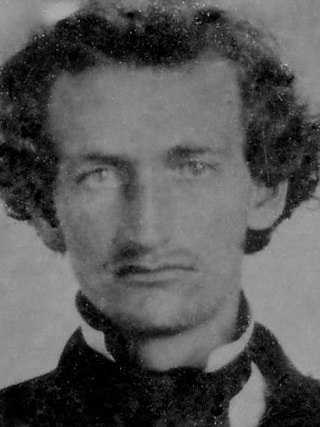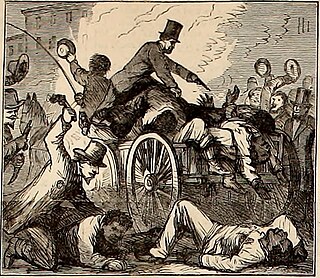Related Research Articles

The Reconstruction era was a period in United States history following the American Civil War, dominated by the legal, social, and political challenges of abolishing slavery and reintegrating the eleven former Confederate States of America into the United States. During this period, three amendments were added to the United States Constitution to grant equal civil rights to the newly freed slaves. Despite this, former Confederate states often used poll taxes, literacy tests, and terrorism to discourage or prevent voting and intimidate and control people of color.
The Radical Republicans were a political faction within the Republican Party originating from the party's founding in 1854—some six years before the Civil War—until the Compromise of 1877, which effectively ended Reconstruction. They called themselves "Radicals" because of their goal of immediate, complete, and permanent eradication of slavery in the United States. The Radical faction also included, though, very strong currents of Nativism, anti-Catholicism, and in favor of the Prohibition of alcoholic beverages. These policy goals and the rhetoric in their favor often made it extremely difficult for the Republican Party as a whole to avoid alienating large numbers of American voters from Irish Catholic, German-, and other White ethnic backgrounds. In fact, even German-American Freethinkers and Forty-Eighters who, like Hermann Raster, otherwise sympathized with the Radical Republicans' aims, fought them tooth and nail over prohibition.

The Bureau of Refugees, Freedmen, and Abandoned Lands, usually referred to as simply the Freedmen's Bureau, was a U.S. government agency of early post American Civil War Reconstruction, assisting freedmen in the South. It was established on March 3, 1865, and operated briefly as a federal agency after the War, from 1865 to 1872, to direct "provisions, clothing, and fuel... for the immediate and temporary shelter and supply of destitute and suffering refugees and freedmen and their wives and children".

In the history of the United States, carpetbagger is a largely historical pejorative used by Southerners to describe allegedly opportunistic or disruptive Northerners who came to the Southern states after the American Civil War, and were perceived to be exploiting the local populace for their own financial, political, and/or social gain. The term broadly included both individuals who sought to promote Republican politics, and individuals who saw business and political opportunities because of the chaotic state of the local economies following the war. In practice, the term carpetbagger often was applied to any Northerners who were present in the South during the Reconstruction Era (1865–1877). The word is closely associated with scalawag, a similarly pejorative word used to describe native white Southerners who supported the Republican Party-led Reconstruction.

The Colfax massacre, sometimes referred to as the Colfax riot, occurred on Easter Sunday, April 13, 1873, in Colfax, Louisiana, the parish seat of Grant Parish. An estimated 62–153 Black militia men were murdered while surrendering to a mob of former Confederate soldiers and members of the Ku Klux Klan. Three white men also died during the confrontation.

Eric Foner is an American historian. He writes extensively on American political history, the history of freedom, the early history of the Republican Party, African American biography, the American Civil War, Reconstruction, and historiography, and has been a member of the faculty at the Columbia University Department of History since 1982. He is the author of several popular textbooks. According to the Open Syllabus Project, Foner is the most frequently cited author on college syllabi for history courses. According to historian Timothy Snyder, Foner is the first to associate the storming of the Capitol on January 6, 2021 with section three of the Fourteenth Amendment to the Constitution.

The Joint Committee on Reconstruction, also known as the Joint Committee of Fifteen, was a joint committee of the 39th United States Congress that played a major role in Reconstruction in the wake of the American Civil War. It was created to "inquire into the condition of the States which formed the so-called Confederate States of America, and report whether they, or any of them, are entitled to be represented in either house of Congress.”
The Redeemers were a political coalition in the Southern United States during the Reconstruction Era that followed the American Civil War. Redeemers were the Southern wing of the Democratic Party. They sought to regain their political power and enforce White supremacy. Their policy of Redemption was intended to oust the Radical Republicans, a coalition of freedmen, "carpetbaggers", and "scalawags". They were typically led by White yeomen and dominated Southern politics in most areas from the 1870s to 1910.
The Coushatta massacre (1874) was an attack by members of the White League, a white supremacist paramilitary organization composed of white Southern Democrats, on Republican officeholders and freedmen in Coushatta, the parish seat of Red River Parish, Louisiana. They assassinated six white Republicans and five to 20 freedmen who were witnesses.
Black Reconstruction in America: An Essay Toward a History of the Part Which Black Folk Played in the Attempt to Reconstruct Democracy in America, 1860–1880 is a history of the Reconstruction era by W. E. B. Du Bois, first published in 1935. The book challenged the standard academic view of Reconstruction at the time, the Dunning School, which contended that the period was a failure and downplayed the contributions of African Americans. Du Bois instead emphasized the agency of Black people and freed slaves during the Civil War and Reconstruction and framed the period as one that held promise for a worker-ruled democracy to replace a slavery-based plantation economy.
Neoabolitionist is a term used in historiography to characterize historians of race relations motivated by the spirit of racial equality typified by the abolitionists who fought to abolish slavery in the mid-19th century. They write especially about African-American history, slavery in the United States, the American Civil War and the Reconstruction Era.
The Dunning School was a historiographical school of thought regarding the Reconstruction period of American history (1865–1877), supporting conservative elements against the Radical Republicans who introduced civil rights in the South. It was named for Columbia University professor William Archibald Dunning, who taught many of its followers.
William Archibald Dunning was an American historian and political scientist at Columbia University noted for his work on the Reconstruction era of the United States. He founded the informal Dunning School of interpreting the Reconstruction era through his own writings and the Ph.D. dissertations of his numerous students.

James M. Hinds was the first U.S. Congressman assassinated in office. He served as member of the United States House of Representatives for Arkansas from June 24, 1868 until his assassination by the Ku Klux Klan. Hinds, who was white, was an advocate of civil rights for black former slaves during the Reconstruction era following the American Civil War.
In the United States, a freedmen's town was an African American municipality or community built by freedmen, formerly enslaved people who were emancipated during and after the American Civil War. These towns emerged in a number of states, most notably Texas. They are also known as freedom colonies, from the title of a book by Sitton and Conrad.

This is a selected bibliography of the main scholarly books and articles of Reconstruction, the period after the American Civil War, 1863–1877.
Historiography examines how the past has been viewed or interpreted. Historiographic issues about the American Civil War include the name of the war, the origins or causes of the war, and President Abraham Lincoln's views and goals regarding slavery.
The civil rights movement (1865–1896) aimed to eliminate racial discrimination against African Americans, improve their educational and employment opportunities, and establish their electoral power, just after the abolition of slavery in the United States. The period from 1865 to 1895 saw a tremendous change in the fortunes of the Black community following the elimination of slavery in the South.

The Fiery Trial: Abraham Lincoln and American Slavery is a historical non-fiction book written by American historian Eric Foner. Published in 2010 by W. W. Norton & Company, the book serves as a biographical portrait of United States President Abraham Lincoln, discussing the evolution of his stance on slavery in the United States over the course of his life. The Fiery Trial, which derives its title from Lincoln's Annual Message to Congress of December 1, 1862, was the 22nd book written by Foner, the DeWitt Clinton Professor of History at Columbia University. It was praised by critics and won the 2011 Pulitzer Prize for History, the Bancroft Prize, and the Lincoln Prize.

The Freedmen massacres were a series of attacks on African-Americans which occurred in the states of the former Confederacy during Reconstruction, in the aftermath of the American Civil War. Many of these incidents were the result of a struggle over political power, especially after the voting rights of freedmen were protected through the Fifteenth Amendment to the United States Constitution. Robert Smalls estimated that overall 53,000 African-American were killed in post-war racial terrorism, an estimate increasingly considered plausible by historians.
With reference to emancipation, we are at the beginning of the war.
References
- ↑ McFeely, William S. (1988-05-22). "A Moment of Terrifying Promise". The New York Times . Archived from the original on 2021-03-17. Retrieved 2021-03-17.
I found letters from ordinary people received by governors in a half-dozen Southern states [...] Ten years ago, when I began, I was a visiting professor at the University of South Carolina. The governors' papers there alone consisted of 121 boxes. The letters told me what was going on in people's minds because they came from all classes - former slaves, members of the Ku Klux Klan, white farmers, black leaders. They went to the grass roots of life."..."Mine isn't statistical but analytical history. I didn't use computers because great issues are not susceptible to analysis by the numbers.
- ↑ McFeely, William S. (1988-05-22). "A Moment of Terrifying Promise". The New York Times . Archived from the original on 2021-03-17. Retrieved 2021-03-26.
[Foner's] synthesis is the product not only of a dauntingly thorough reading of this large body of literature, but also of his own extensive research. The result is a compelling narrative that begins during the Civil War as slaves sought freedom by escaping from their pursuing masters and coming into Union Army camps.
- ↑ Nash, Gary (1988-10-16). "1988 Book Prize Winner: History: The Killing of 'Birth of a Nation.'". Los Angeles Times . Archived from the original on 2021-03-26. Retrieved 2021-03-26.
Eric Foner's long, brilliant and stylish book [...] is of signal importance, not only to understanding one of the most controversial periods in American history but to comprehending the course of race relations in this country during the last century.
- ↑ Pole, J. R. (1990-01-11). "During the war and after the war". London Review of Books. 12 (1). Archived from the original on 2020-10-24. Retrieved 2020-10-24.
Earlier interpretations of the history of Reconstruction by Stampp and Franklin did much to lay down guidelines for the 'Second Reconstruction' school, whose approach reflected the mood of the modern civil rights movement: but Foner has brought under control an enormously greater mass of information.
- ↑ "Book Prizes – Los Angeles Times Festival of Books» 1988 Los Angeles Times Book Prize Winners". Los Angeles Times . 2014-01-04. Archived from the original on 2014-01-04. Retrieved 2014-01-04.
History Reconstruction: America's Unfinished Revolution, 1863-1877 by Eric Foner (Harper & Row)
- ↑ "Two Historians Receive 1989 Bancroft Prizes". The New York Times. April 6, 1989. Retrieved April 30, 2024.
- ↑ Foner, Eric (1990-01-01). A Short History of Reconstruction, 1863-1877. Harper & Row. ISBN 9780060964313 – via archive.org.